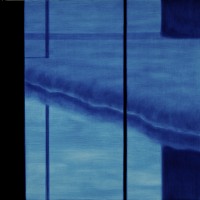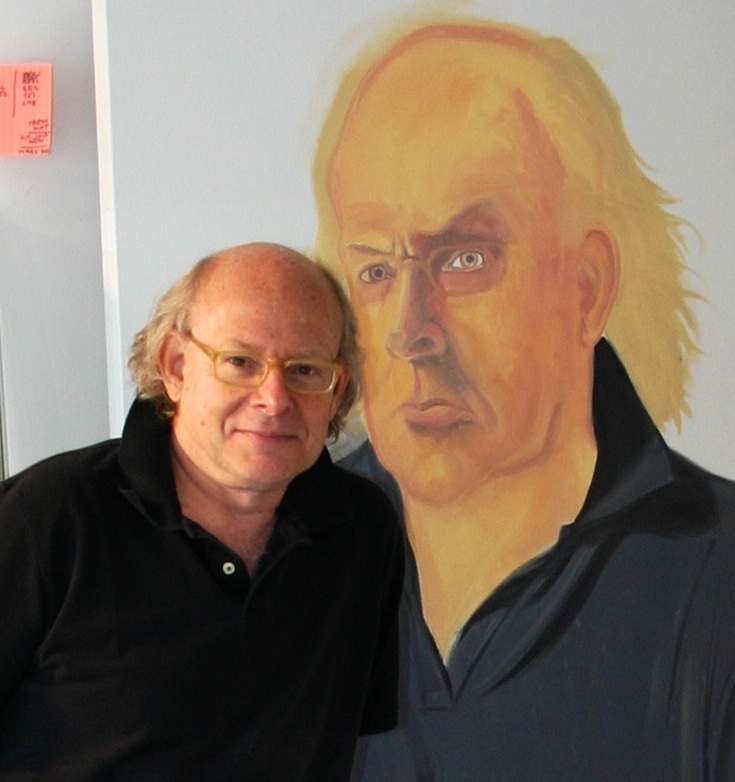We’re not in Kansas any more
I want to believe these are landscapes. But I know it’s not true. Sure, they have the vocabulary that informs landscape painting. But these images position us, instead, at a strange nexus between a place we feel we should recognize and a space that defines the life of abstract painting.
And it’s not just that these monochromatic landscapes are seen solely through a lens of Prussian blue. Rather, Leeds uses blue as just the beginning of a subtle process of disengaging us from the literalism of landscape and inviting us to embark on a fresh visual investigation that is both intellectual and mystical. Blue also recalls the emotional response similar to that conveyed by American tonalist painters at the turn of the century, referencing that twilight time when day transforms to night, or the crepuscular quietude where life passes to death.
Landscape paintings traditionally reflect our world. Instead, Leeds ushers us into a new reality that is void of narrative. It is at once strangely familiar yet somewhat uncomfortable. Once landed, we immediately seem to recognize tree trunks, riverbanks, water, reflections, and even clouds. But as we continue to be led about within this silent but subtly vibrant space we discover that it is artificial, governed by geometric and linear elements. The “trees” have no branches and may even be industrial poles or cables. The riverbanks may simply be the edge of a huge and mysterious confection. And the clouds bear an eerie resemblance to NASA’s photographs of the Jovian atmosphere of Venus. At that point of realization, those who begin to feel the twinges of fear may even recall the Eagles’ famous song, “Hotel California,” where the narrator desperately seeks a way out of the hotel, saying “I had to get back to the place I was before.” But phantom shadows and reflections continue to lure us into believing in the beauty of this seemingly familiar place. And the blue induces a mood that is both contemplative and calming. It assuages our fear of the other-worldliness that is this place.
Forget place. This is really a momentary world carefully woven together to make us experience the fundamentals of abstract painting anew: the creation of space and movement on a canvas. For Leeds, space is about rendering rhythm. Landscape is simply a fact, just like his blue is a fact. Landscape is simply the mechanism used to hook us into moving about within the space. By limiting the elements, the painter invites us to contemplate a world that is completely free of the endless choices and options posed in all aspects of our daily lives. Here is a complete escape from the daily bombardment of words and images gushing from television, the internet, magazines, and newspapers. In the process of eliminating this cacophony, these creations become evidence of a spiritual quest.
The suggested reality of landscape is therefore merely a reference point, for it is subordinated to the evocation of space, rhythm, and atmosphere in what is primarily a geometric space. We are reminded that the course of twentieth century painting — from Impressionism to Abstract Expressionism to Minimalism — was not conveniently linear. This is especially easy to grasp in landscape painting, where we come to understand the divergent paths of many groups. American Impressionists, Regionalists, Scene painters, Surrealists, Classic Realists, and Abstractionists all overlapped, painting in the first half of the twentieth century. We started with a more or less “natural” approach to expressing place and space, and we wound up with Jackson Pollock’s intricate webbed layers of drip-action paintings that explored the microcosm and the macrocosm at once. Barnett Newman pushed the boundaries of abstract expressionism even further, emerging with his “zip” paintings. Here he distilled the visual experience to the primacy of color fields and activated thin vertical stripes (zips) as vibrant elements. For Newman, the experience was a spiritual one, too, but contemporary art critics had difficulty neatly categorizing these paintings let alone mediating over them.
And it is in this respect that Leeds, too, throws us a curve. Just as Newman created his own unique expression in the purely abstract and minimalist realm, Leeds has forged an entirely different path. Paintings like “Distant Fog with Two” and “Twilight Notes” take over where Newman left off. Leeds not only understands the subtle expressive role of vertical lines of varying widths, but spends hours carefully calculating their positions, placing these “zips” so that they lead our eye across the image and cycle back again.
Without the company of Leeds’ other paintings hanging side-by-side, some works may even be viewed simply as pure abstraction. For example, “Three Shapes” appears to consist simply of three dynamically-positioned shapes. While the title is deliberately simplistic, referring to our immediate impression, the artist hopes we observe the subtle differentiations whereby the shapes become four. He even feels it is essential to consider the canvas itself as a fifth foundational shape. Landscape is only referenced minimally.
Eventually, we discover that a subtle visual geometry reinforces the mystical atmosphere of every work. In “Spatial Squares” four equal squares set up the dynamics to begin our movement through the space. But two more squares of equal size can be found in the central area of lighter blue. And within those squares, two smaller squares balance each other as sky and reflection. The space begins to pulse because the widest dark stripe in the right foreground is the same width as the central tree trunk and its reflection. (Note that the reference to “tree trunks” is merely a descriptor. Whether we believe they are trees or not holds little importance for the artist.) Meanwhile, the thin dark trunk at far left is exactly the same width as the vertical stripe that starts as sky and ends as reflection. The painting is the result of long meditations and calculations, all aimed at exploring space. Paintings like “Staccato” resoundingly reconfirm the artist’s role as a bold explorer of altered realms. The commanding presence of this eight-foot by twenty-foot tour de force is yet another architectonic dance through space that is both lyrical and powerful.
Thus, while reintroducing the vocabulary of landscape, Leeds brings us back full circle to what seems to be a natural place. There’s just one problem. It’s not a landscape after all. That portal has been closed. A new portal to the abstract has been opened. As we discover that rhythm is at the core of these paintings, we revel in a new type of visual lyrics while humming, “what a long strange trip it’s been.”
Peter Hastings Falk
Surrealism: Visionary Blue Landscapes
-
 DETAILS
DETAILSWoven Space, 2009
40 x 40 inches (101.6 x 101.6 cm)
-
 DETAILS
DETAILSWoven Space, 2009
40 x 40 inches (101.6 x 101.6 cm)
No Press releases found.
No News found.
No Events Found.

